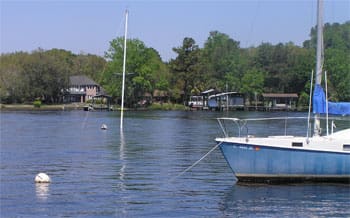To the editor: Boating is all about staying on top of the water as you move from point A to point B. But gravity will not be denied here: all things will find their way to the lowest point. And if not properly attended to, boats will find their way to the bottom.
“Boats leak,” said the salesman as we looked at a used sailboat a few years ago. “From above, below, and from the side, water is always trying to find its way in.” Sure enough, on the first night aboard our new (used) Catalina 34, I noticed the bilge pump cycle on, and off, roughly once per minute. The next day I traced the leak to the prop shaft and stuffing box from which water flowed at an alarming rate (some flax packing took care of that problem).
From then on the thought of coming to the marina and finding our baby sitting on the bottom mortified me more than I like to admit. Later that year a boat a few docks away made the trip to terra firma when the owner allowed the battery to go dead. A month after that I had my first scare when, after an unusually cold spell on the Potomac, I came on board to find the bilge frozen solid, with water just below the floorboards and steadily rising (a light bulb and extension cord took care of that problem).
When a boat sinks, be it at the slip, mooring, or underway, the owner’s problems are manifold and incredibly expensive. A towing company will usually instruct you to quickly contact a salvage company to re-float the boat, after which you will be presented with a bill for a large percentage of the boat’s post casualty value or, if the sinking is near a navigable channel the U.S. Coast Guard will remove the boat and charge the owner a fee and a fine.
Some sunken boats result in the owner simply walking away. Government agencies are keenly aware of this and are usually quick to act and recover financial damages. Derelicts are an eyesore, leak hazardous waste, and are a hazard to navigation. Many communities in Florida and the Gulf are dealing with a rash of derelicts that they must remove themselves using taxpayer dollars.
It was Christmas Day that my own sinking nearly happened. I had been having trouble with the connections on the bilge pump and had just returned from a one-week cruise. As we opened presents, a dark thought occurred to me: the bilge pump had failed, the boat was sinking. Don’t be paranoid, the other side of my brain argued, enjoy Christmas and relax. But the left side won and I made the hour ride to the boat.
Before I was aboard I could see that something was awry. The bootstrap didn’t look right and she had a slight list to port. I opened the hatch and saw that the icy Chesapeake was inside the boat, about a foot above the floorboards. My head ached and my hands shook as I methodically rocked the manual bilge pump up and down until there were blisters on both hands. I cursed myself for having trusted a faulty piece of equipment and at the same time thanked God for the best Christmas present I had ever received.
There’s nothing quite like the thrill of owning a boat, and the freedom that comes with it. It’s a feeling that few things have matched in my life, but it carries with it the responsibility to ensure that the water remains on the outside of the hull.
—Robert Beringer’s Catalina 34, Ukiyo, is based on the St. John’s River in Florida. He holds a USCG 50-ton license and works as a college administrator.

